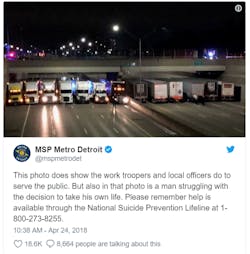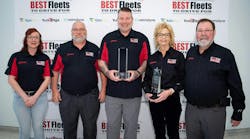At around 1 a.m. on April 24, police received a call that a man was threatening to jump off the Coolidge Highway overpass onto I-696 in Metro Detroit. What happened next captured the attention of the country and the world as 13 trucks lined up on the east and westbound lanes of the interstate so if the man did jump, he would only fall five or six feet onto a truck instead of more than 15 ft. onto the pavement.
The photo of the truck convoy went viral garnering millions of views. We spoke with Michigan State Police First Lt. Michael Shaw about what the public doesn’t know about the incident and how truck drivers and police worked together to save lives.
(Editor’s note: We attempted to contact several of the truckers involved in the lineup but were unsuccessful.)
What doesn’t the public know about this incident?
I think there is some misconception that the truckers did this all on their own and they really didn’t. I don’t want to make it sound like 13 truck drivers just arbitrarily on their own drove underneath the overpass and sat there because that was one of the stories getting out there. If it was true, we would be promoting that, but that’s not exactly how it happened.
How did the lineup happen?
When we see a situation like this, the first thing we do is close off that portion of the freeway because we don’t want traffic running underneath the overpass. Believe it or not, some drivers beep and say stupid things [to the potential jumper] as they're going by. As a trooper directs traffic off the exit ramp, they will start identifying semi-trucks and he’ll grab just one truck and say ‘hey, I need you to continue on down the freeway.’ They’ll continue to the next trooper who will actually line them up underneath the overpass.
You’ve done this sort of thing before?
Absolutely. It’s not an everyday occurrence. In my 20-some years, I can think of maybe a couple of times that we've actually had enough time to cover an entire east and westbound freeway compared to usually just one or two. Ninety-nine percent of the time, we've been pretty successful, thank goodness, and talked most people off the bridge and to get the help they need. It normally doesn’t take this long, but this incident took us some time to get him to the point where he was willing to accept help.
Often, these type of situations fix themselves, so to speak, within 20 to 25 minutes. Maybe we’ll get one or two trucks lined up underneath just right where the person is. This particular time, when that photo was taken, it was two-and-a-half to three hours into the incident. We were actually able to run enough trucks underneath to cover the whole overpass. Usually, it happens so fast that we get one, maybe two semis under there, and that’s all we get. No one ever takes a picture of that. In general, we don’t take a lot of photos of our tactics. We just never talk about it with the media. We do it and move on.
Are drivers usually receptive to being used in for this?
One thing that we consider [is the cost to the driver]. We tell them right at the beginning what we need them to do. And if somebody says ‘no,’ we wouldn’t make them continue on, unless it’s something like they were the first truck and we had to get one underneath there [to start the ball rolling]. Then yeah, we would probably hijack you and take your truck and continue on. But usually if we’ve already got a couple down there and if a driver – for whatever reason, some employers are a lot different than other ones – really stresses that they would lose their employment, then naturally we’re going to send them off the exit ramp and find the next one. We were pretty fortunate in this particular case. It was about one or two in the morning. All that’s on the freeways during that time usually is trucks. We were able to get quite a few right off the bat. We sometimes refer to asking drivers for help as being ‘volun-told.’
I know there was some reluctance at MSP to send the photo into the Twittersphere. Why?
At first, we feared that the next person who [wanted to jump] would know what we were trying to do and it might stop us. But then we took it as an opportunity to stress the fact that there is help out there through the suicide hotline, clergy, relatives and 911. There's always something out there that that might keep that person from going on the overpass. We’d rather get them help beforehand.
Our reason for going public with the photo wasn’t to say that our troopers did a great job. I’m not saying anything about them. The truckers did a great job. I’m not holding anything back against them, either, but in that photo there's a guy up there who was making the decision whether to end his own life or not. That was the part we really wanted to key in on as far as the great job that the officers and the truckers did. There was someone up there that felt things were so bad that they would rather die. We figured that there are some other steps they could’ve taken before stepping onto that overpass.
Where is that person now?
I believe that person is out of the hospital and receiving the care that he needs. He was suffering from a family disturbance; a custody issue was his trigger. Hopefully, he’ll remember what those truck drivers did for him that day and decide that there's nothing worth losing your life over.




